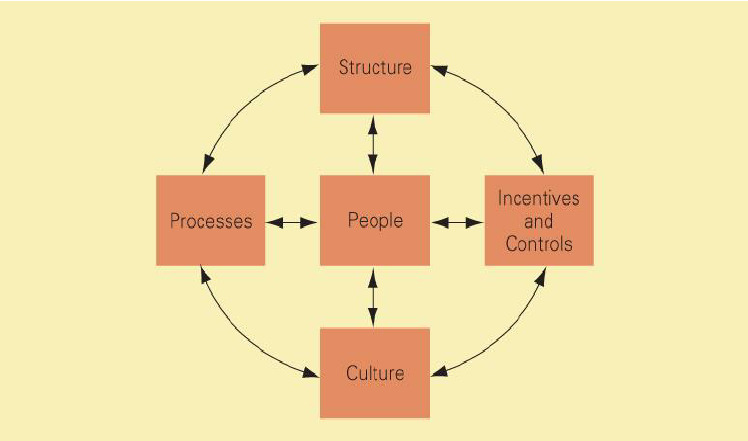Organizations, by definition, are entities with boundaries. External boundaries separate a company from its suppliers and customers and define its geographic reach. Internal boundaries separate the departments between each other, management from employees. Such lines of differentiation have been necessary. Different departments in the organization work towards the common goal the overall success of the business. However, companies that thrive within the new environment of global competition, rapidly changing technologies, and shifting markets are characterized by not having many boundaries. The new model of success is defined as “boundaryless organization”, a term created by Jack Welch during his term as CEO of GE.… Read the rest
Management Basics
Organizational Architecture
By organizational architecture, we mean the entire organization, including organizational structure, control systems and incentives, processes, organizational culture and people. In this case, there are three conditions to be fulfilled by an organization to make the organization profitable. First, various elements of the organization shall be parallel to each other. Second, organizational strategy should always be consistent with the organizational structure, and finally, strategies and organizational structure must be consistent with the competitive conditions prevailing in the firm’s market that are the strategy, architecture and competitive environment.
As noted above, the organizational architecture is the totality of the organization itself which consists of various components.… Read the rest
Employee Empowerment – Meaning and Its Effectiveness
In such a competitive environment, the organizations have to continuously provide quality products, better services and need to bring innovation to stay in the business and generate profits. To conduct such activities, efficient and empowered employees are essential.
In the past, the authority was not delegated to the employees and it centered on the managers who were responsible for making all the decisions in the interest of the organizations. This had limited the creativity to show up since the employees were not able to express or share their ideas. Empowerment in the recent years has been considered as the most important factor that contributes to the success of the organization.… Read the rest
Factors that Contribute to Successful Organizations
An organization is said to be effective when it achieves the expected output as by the management. An effective organization earns profit for investors, offers satisfactory service to clients and has a potential for growth and development. Organizations are able to survive chaotic times due to their adaptability to change. The management which provides good leadership experiences employee retention and the workers are more productive than one with a demoralized workforce. An organization has to facilitate training and continuous learning for employees, the organization has contingency methods of operation that is different situations are handled by the different appropriate ways. An organization has to engage the input of its employees in the decision making.… Read the rest
The Impact of Demographic Characteristics and Cultural Diversity on Behaviour within a Group
Groups can become a high performance team by following organizational goals and strategic planning, while demographic characteristics and cultural diversity can influence a team in many ways. Cultural diversity and demographic characteristics can help achieve goals and people should be aware how they can contribute to reaching goals in an organization. This article will discuss the impact of demographic characteristics and cultural diversity on behavior within a group, and how individuality will sometimes contribute to detract from high-performance in teams.
Numerous attempts have been made by several organizations in order to gain competitive edge over their competitors through management concepts and practices.… Read the rest
Important Features of Japanese Management
The culture of Japanese management is generally limited to Japan’s large corporations. These flagships of the Japanese economy provide their workers with excellent salaries and working conditions and secure employment. These companies and their employees represent the business elite of Japan: qualification for employment is limited to the men and the few women who graduate from the top thirty colleges and universities in Japan.
Placement and advancement of Japanese workers is heavily based on educational background. The students, who are not admitted to the most highly rated colleges, rarely have the chance to work for a large company; instead, they have to seek positions in small and medium-sized firms that cannot offer comparable benefits and prestige.… Read the rest

